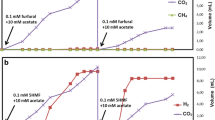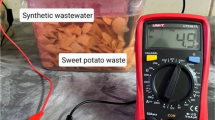Abstract
Furanic and phenolic compounds are problematic compounds resulting from the pretreatment of lignocellulosic biomass for biofuel production. Microbial electrolysis cell (MEC) is a promising technology to convert furanic and phenolic compounds to renewable H2. The objective of the research presented here was to elucidate the processes and electron equivalents flow during the conversion of two furanic (furfural, FF; 5-hydroxymethyl furfural, HMF) and three phenolic (syringic acid, SA; vanillic acid, VA; 4-hydroxybenzoic acid, HBA) compounds in the MEC bioanode. Cyclic voltammograms of the bioanode demonstrated that purely electrochemical reactions in the biofilm attached to the electrode were negligible. Instead, microbial reactions related to the biotransformation of the five parent compounds (i.e., fermentation followed by exoelectrogenesis) were the primary processes resulting in the electron equivalents flow in the MEC bioanode. A mass-based framework of substrate utilization and electron flow was developed to quantify the distribution of the electron equivalents among the bioanode processes, including biomass growth for each of the five parent compounds. Using input parameters of anode efficiency and biomass observed yield coefficients, it was estimated that more than 50% of the SA, FF, and HMF electron equivalents were converted to current. In contrast, only 12 and 9% of VA and HBA electron equivalents, respectively, resulted in current production, while 76 and 79% remained as fermentation end products not further utilized in exoelectrogenesis. For all five compounds, it was estimated that 10% of the initially added electron equivalents were used for fermentative biomass synthesis, while 2 to 13% were used for exoelectrogenic biomass synthesis. The proposed mass-based framework provides a foundation for the simulation of bioanode processes to guide the optimization of MECs converting biomass-derived waste streams to renewable H2.




Similar content being viewed by others
References
Bache R, Pfennig N (1981) Selective isolation of Acetobacterium woodii on methoxylated aromatic acids and determination of growth yields. Arch Microbiol 130:255–261
Bond DR, Strycharz-Glaven SM, Tender LM, Torres CI (2012) On electron transport through Geobacter biofilms. ChemSusChem 5:1099–1105
Borole AP, Mielenz JR (2011) Estimating hydrogen production potential in biorefineries using microbial electrolysis cell technology. Int J Hydrog Energy 36:14787–14795
Borsje C, Liu D, Sleutels THJA, Buisman CJN, ter Heijne A (2016) Performance of single carbon granules as perspective for larger scale capacitive bioanodes. J Power Sources 315:690–696
Freguia S, Rabaey K, Yuan Z, Keller J (2007) Electron and carbon balances in microbial fuel cells reveal temporary bacterial storage behavior during electricity generation. Environ Sci Technol 41:2915–2921
Freguia S, Rabaey K, Yuan Z, Keller J (2008) Syntrophic processes drive the conversion of glucose in microbial fuel cell anodes. Environ Sci Technol 42:7937–7943
Haddock JD, Ferry JG (1989) Purification and properties of phloroglucinol reductase from Eubacterium oxidoreducens G-41. J Biol Chem 264:4423–4427
Hamelers HVM, ter Heijne A, Stein N, Rozendal RA, Buisman CJN (2011) Butler–Volmer–Monod model for describing bio-anode polarization curves. Bioresour Technol 102:381–387
Jones S, Holladay J, Valkenburg C, Stevens D (2009) Production of gasoline and diesel from biomass via fast pyrolysis, hydrotreating and hydrocracking: a design case. Pacific Northeast National Laboratory, Richland
Kang CS, Eaktasang N, Kwon DY, Kim HS (2014) Enhanced current production by Desulfovibrio desulfuricans biofilm in a mediator-less microbial fuel cell. Bioresour Technol 165:27–30
Kato Marcus A, Torres CI, Rittmann BE (2007) Conduction-based modeling of the biofilm anode of a microbial fuel cell. Biotechnol Bioeng 98:1171–1182
Korth B, Rosa LFM, Harnisch F, Picioreanu C (2015) A framework for modeling electroactive microbial biofilms performing direct electron transfer. Bioelectrochemistry 106:194–206
Lalaurette E, Thammannagowda S, Mohagheghi A, Maness P-C, Logan BE (2009) Hydrogen production from cellulose in a two-stage process combining fermentation and electrohydrogenesis. Int J Hydrog Energy 34:6201–6210
Lewis AJ, Ren S, Ye X, Kim P, Labbe N, Borole AP (2015) Hydrogen production from switchgrass via an integrated pyrolysis–microbial electrolysis process. Bioresour Technol 195:231–241
Liu H, Logan BE (2004) Electricity generation using an air-cathode single chamber microbial fuel cell in the presence and absence of a proton exchange membrane. Environ Sci Technol 38:4040–4046
Liu H, Grot S, Logan BE (2005) Electrochemically assisted microbial production of hydrogen from acetate. Environ Sci Technol 39:4317–4320
Logan BE (2009) Exoelectrogenic bacteria that power microbial fuel cells. Nat Rev Microbiol 7:375–381
Logan BE, Call D, Cheng S, Hamelers HVM, Sleutels THJA, Jeremiasse AW, Rozendal RA (2008) Microbial electrolysis cells for high yield hydrogen gas production from organic matter. Environ Sci Technol 42:8630–8640
Marsili E, Baron DB, Shikhare ID, Coursolle D, Gralnick JA, Bond DR (2008) Shewanella secretes flavins that mediate extracellular electron transfer. Proc Natl Acad Sci U S A 105:3968–3973
Monlau F, Sambusiti C, Barakat A, Quéméneur M, Trably E, Steyer JP, Carrère H (2014) Do furanic and phenolic compounds of lignocellulosic and algae biomass hydrolyzate inhibit anaerobic mixed cultures? A comprehensive review. Biotechnol Adv 32:934–951
Piotrowski JS, Zhang Y, Sato T, Ong I, Keating D, Bates D, Landick R (2014) Death by a thousand cuts: the challenges and diverse landscape of lignocellulosic hydrolysate inhibitors. Front Microbiol 5:1–8
Ren L, Siegert M, Ivanov I, Pisciotta JM, Logan BE (2013) Treatability studies on different refinery wastewater samples using high-throughput microbial electrolysis cells (MECs). Bioresour Technol 136:322–328
Rittmann BE, McCarty PL (2001) Environmental biotechnology: principles and applications. McGraw-Hill, New York
Wilson EL, Kim Y (2016) The yield and decay coefficients of exoelectrogenic bacteria in bioelectrochemical systems. Water Res 94:233–239
Zeng X (2016) Biotransformation of Furanic and phenolic compounds with hydrogen production in microbial electrolysis cells. PhD Dissertation, Georgia Institute of Technology, Atlanta, GA, USA
Zeng X, Borole AP, Pavlostathis SG (2015) Biotransformation of furanic and phenolic compounds with hydrogen gas production in a microbial electrolysis cell. Environ Sci Technol 49:13667–13675
Zeng X, Borole AP, Pavlostathis SG (2016a) Inhibitory effect of furanic and phenolic compounds on exoelectrogenesis in a microbial electrolysis cell bioanode. Environ Sci Technol 50:11357–11365
Zeng X, Borole AP, Pavlostathis SG (2016b) Performance evaluation of a continuous-flow bioanode microbial electrolysis cell fed with furanic and phenolic compounds. RSC Adv 6:65563–65571
Zeng X, Collins MA, Borole AP, Pavlostathis SG (2017) The extent of fermentative transformation of phenolic compounds in the bioanode controls exoelectrogenic activity in a microbial electrolysis cell. Water Res 109:299–309
Zhang Y, Angelidaki I (2014) Microbial electrolysis cells turning to be versatile technology: recent advances and future challenges. Water Res 56:11–25
Zhang X, Wiegel J (1990) Isolation and partial characterization of a Clostridium species transforming para-hydroxybenzoate and 3,4-dihydroxybenzoate and producing phenols as the final transformation products. Microb Ecol 20:103–121
Zhang Y, Min B, Huang L, Angelidaki I (2009) Generation of electricity and analysis of microbial communities in wheat straw biomass-powered microbial fuel cells. Appl Microbiol Biotechnol 75:3389–3395
Acknowledgments
This manuscript has been co-authored by UT-Battelle, LLC under Contract No. DE-AC05-00OR22725 with the US Department of Energy. The US Government retains and the publisher, by accepting the article for publication, acknowledges that the US Government retains a non-exclusive, paid-up, irrevocable, worldwide license to publish or reproduce the published form of this manuscript, or allow others to do so, for US Government purposes. The Department of Energy will provide public access to these results of federally sponsored research in accordance with the DOE Public Access Plan (http://energy.gov/downloads/doe-public-access-plan).
Author information
Authors and Affiliations
Corresponding author
Additional information
Responsible editor: Philippe Garrigues
Electronic supplementary material
ESM 1
(PDF 128 kb)
Rights and permissions
About this article
Cite this article
Zeng, X., Borole, A.P. & Pavlostathis, S.G. Processes and electron flow in a microbial electrolysis cell bioanode fed with furanic and phenolic compounds. Environ Sci Pollut Res 25, 35981–35989 (2018). https://doi.org/10.1007/s11356-018-1747-2
Received:
Accepted:
Published:
Issue Date:
DOI: https://doi.org/10.1007/s11356-018-1747-2




